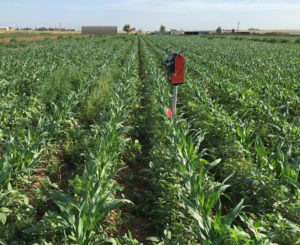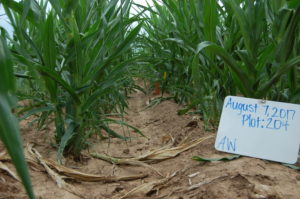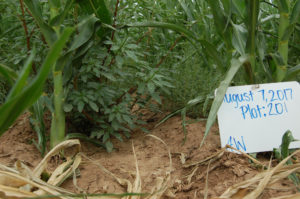Weed control economical, yield-critical in corn
Writer: Kay Ledbetter, 806-677-5608, [email protected]
Contact: Dr. Jourdan Bell, 806-677-5600, [email protected]
AMARILLO – Just how much water are weeds using in a corn crop, and is it more economical to treat or not is the focus of a Texas A&M AgriLife study.

Dr. Jourdan Bell, Texas A&M AgriLife Extension Service agronomist in Amarillo, and her Texas A&M AgriLife Research graduate student Aislinn Walton have found in early results heavy weed pressure could result in a 100-bushels-per acre yield loss on a corn crop.
As groundwater becomes increasingly limited, Panhandle producers are often not able to meet the crop’s full water demands, Bell said. Timely weed management can actually save water and improve yields because weeds are using the crop’s water and nutrients.
“We sometimes see producers miss their preplant herbicide applications and not control weeds until later in the season,” she said. “But our research validates that they have lost a significant portion of their yield potential to early weed pressure. We have seen yield losses of up to 300 percent in our corn herbicide research plots with heavy weed pressure in comparison to plots with good weed control.”

Bell said as they monitored their herbicide plots, “we really began to question how resources were being allocated to weeds, specifically water, so we purposely planted weed plots with kochia, redroot pigweed, morning glory, velvet leaf and barnyardgrass to evaluate weed water use.”
Last year, Walton began monitoring crop water use in corn herbicide research plots with neutron moisture probes. The measured crop water use is actually the evapotranspiration, which is soil evaporation and crop transpiration combined.
“While we have been able to show there is significantly more evapotranspiration in plots with heavy weed pressure, we really don’t know how much water or transpiration is coming from just the weeds,” Bell said. “A farmer trying to determine whether to spray or not might not be thinking about how much water just your weeds are using.”
In this study, they are portioning evaporation and transpiration.

“This will allow us to get an idea of just how much water is going to the weeds,” Walton said.
This is the second year of the study being conducted by Walton for her thesis project.
In last year’s plots, she showed in the uncontrolled weed plots, 10 more inches per acre of water was used where there was heavy weed pressure — and her corn yield was almost 100 bushels per acre less.
Bell said one of the questions she continuously gets from producers on herbicides is about the cost – at low commodity prices, they are concerned about spending an additional $20, $30 or $40 per acre on herbicides. But when they see how much water is used as well as how much yield is lost to poor weed control, they recognize there is a return on the herbicide investment even at low commodity prices.
The study this year is concentrating on the most efficient time to apply herbicides. In her study, Walton measures leaf area and light penetration through the canopy. The data indicates the water used by weeds early in the season results in reduced leaf area and plant size.
“Plants that start behind stay behind and never catch up,” Bell said. “This is critical because in corn, early competition for resources is affecting ear development. When there is good weed control, there is canopy closure and light interception by leaves. Light is also a very valuable resource. In plots with heavy weed pressure, there is less leaf area and greater light penetration through the canopy.”
Walton’s data show the preplant application is the most critical application for herbicide. She said her leaf area measurements show how important it is early in corn development to control the small weeds and not use the resources needed by the corn.
“If there is anything a farmer can do or is going to do, they need to make that preplant application,” Bell said. “Keep the weeds down at the beginning of the season so we can put the resources toward the crop, which will choke those weeds out later.”


